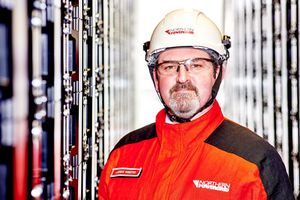
A smart-grid revolution, a northern star of engineering, and an isolated forest community
When it opened in 1876, the Swing Bridge over the River Tyne was a beacon of hydraulic innovation. The Grade II*-listed structure was designed by visionary British engineer William Armstrong, himself a clean energy trailblazer who was the first in the world to light his house with hydroelectricity – 150 years ahead of the critical clean energy discussions at COP26. And now his iconic bridge is at the heart of a new engineering revolution: Northern Powergrid’s first-of-its-kind smart-grid programme Microresilience.
It don’t mean a thing if it ain’t got that swing
You might have recently seen the Swing Bridge jam and be unable to swing when an internal pressure valve failed. The landmark’s electricity cables are also dated and the original 19th-century mechanisms need a bit of help: with Microresilience, we’re giving the critical infrastructure an upgrade, kitting it out with innovative communications technology and a new 100kWh lithium-ion battery system.
“The Swing Bridge is one of Newcastle’s best-loved landmarks,” Newcastle City Councillor Ged Bell recently said. “This investment in the bridge’s power supply will not only keep its streetlights on during a power cut, but improve the reliability of the bridge opening.”
There’s more to Microresilience than bridging old and new technology
COP26 will discuss accelerating the global transition to clean energy against a backdrop of climate emergency. To get there, we’ll need technology to help maintain power to vital infrastructure, increase resilience at sites of older infrastructure, and underpin local power networks as electricity use increases. The Swing Bridge has been chosen to showcase Microresilience’s answers to these needs, but we’re also piloting it 40 miles away, at a very different location: the isolated forest village of Byrness.
Batteries now included
With just 50 homes and the smallest church in Northumberland, Byrness is the last point of habitation on the Pennine Way. In a landscape populated by roe deer and red squirrels, electricity arrives via an overhead power line, and like all overhead networks it can be vulnerable to high winds and storms that can cause windborne debris or vegetation to make contact and cause damage. Those same severe weather events can make delivering a back-up generator challenging, thanks also to the famously winding single-road route to Byrness.
Here, Microresilience will switch customers from the local network to a back-up battery during a power cut – keeping them connected to power while Northern Powergrid works to locate and repair the fault. This can be especially important for those who are medically dependent on electricity or particularly vulnerable. In a power cut, customers can be alerted that they are ‘on battery’ and urged to be energy smart and conserve power.
Why protecting power is more vital than ever
As the UK races to decarbonise and meet net zero emissions targets we’ll all become increasingly dependent on electricity to power our lives, from heating our homes to charging our cars. Protecting people’s power will become ever more vital, but electricity networks are under increasing threat from extreme weather and cyber-attacks: The UK Climate Change Committee recently highlighted that protecting the power system from climate-related failure is an urgent priority. With climate resilience at the heart of our future, Microresilience zooms in to meet unique local needs, protecting and increasing the resilience of individual ‘micro’ areas of the network.
How Microresilience looks ahead to net zero
As an essential part of our £83m smart grid enablers programme, Microresilience will also prepare the regional economy for rapid growth of electric vehicles, domestic heat pumps and renewable power. In particular, the project will pave the way for innovative uses of electric vehicle batteries and how they could provide new flexibility and help keep the lights on for customers.
My colleague Iain Miller, our Head of Innovation, summed it up nicely: “As we become more reliant on electric vehicles and electric heating in response to climate change, our goal is to use the most affordable and effective smart technologies to achieve true resilience at the lowest cost to our customers. We think that William Armstrong himself would be impressed.”
By Andrew Webster, Innovation Project Manager, Northern Powergrid




